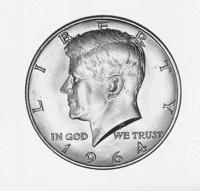You had to be there. The release of the first Kennedy half dollars was the biggest thing to hit coin collecting in many years. As the July 1964 issue of Boy’s Life put it, no other coin had quite the same reception as the 1964 Kennedy half dollar.
Kennedy was assassinated on Nov. 22, 1963. A few days later, Mint Director Eva Adams telephoned engraver Gilroy Roberts at the Mint and informed him that a Kennedy quarter, half dollar or dollar were being considered.
On Nov. 27, Adams called again and said the half dollar had been chosen for the new design. First Lady Jacqueline Kennedy did not want to replace George Washington on the quarter, and a silver dollar revival was questionable.
A Dec. 10, 1963 statement from President Lyndon B. Johnson to Congress, conveyed by Press Secretary Pierre Salinger, proposed the “coinage of 50-cent pieces with the likeness of the late John Fitzgerald Kennedy.”
Congressman John William Wright Patman, of Texas, said the total cost of converting the half dollar from the Franklin to the Kennedy design would be less than $1,000.
Johnson signed the Kennedy half dollar legislation into law on Dec. 30, 1963. The design was ready ahead of schedule, in record time. Roberts adapted the Kennedy portrait from a Mint medal. The Presidential Seal on the reverse, engraved by Frank Gasparro, also was adapted from the medal.
Gasparro was particularly concerned with the intricacy of the design. Every detail had to be exactly right, he wrote, because, “Errors on coins are keenly sought by coin enthusiasts.”
Trial-strike Kennedy half dollars were made on Dec. 13, 1963, and later examined by Jacqueline Kennedy and Attorney General Robert Kennedy. Their suggestions resulted in slightly revised models and new trial strikes.
Kennedy half dollar production began simultaneously at Philadelphia and Denver in January 1964. The first examples were released on March 24, 1964. Two days later, each member of Congress received a Kennedy half dollar from President Johnson, with a note stating it was the first of its kind issued by the Treasury.
Treasury cited the huge expansion of the vending industry and the hoarding of Kennedy half dollars as reasons for the half dollar shortage of the previous three years. Treasury Secretary Robert Wallace said the coins had been “gobbled up” as mementoes.
More than 4.1 billion Kennedy half dollars have been struck. But the 1964 Kennedys are the only 90 percent silver examples struck for circulation.

An ad in the November 1965 issue of Popular Mechanics offered a “John F. Kennedy 1964-P Mint Set” for $2.95. The ad stated, “The silver coins we have known will no longer be minted…the silver in the Kennedy half dollar [has been] reduced to 40%.”
Kennedy half dollars with reduced silver content were struck through 1970. In 1971, the Mint began striking copper-nickel clad Kennedy halves. None were struck in 1975.
The Kennedy half dollar received an Independence Hall reverse for the Bicentennial.


I have a 1922 peace dollar coin. Worn off. You can still see partial 1922. And the eagle in the back. Is it still worth?